Jungle Cruise is a great ride for the family — both the real ride and the movie, but both are also problematic in their depictions of marginalized groups.
SPOILERS AHEAD FOR JUNGLE CRUISE
I truly enjoyed Jungle Cruise. This was my first theater-going experience in over a year, and the movie’s spectacle and action made it a great choice to see on the big screen. Dwayne Johnson and Emily Blunt’s charm serve as the backbone of this movie. Disney tries (and fails) yet again at slipping in a sliver of gay representation. In the meantime, the fantastic visual effects distract from the movie’s issues. While the primary antagonist is a hollow, mustache-twirling stock villain, the secondary villains are a delight and surprisingly macabre for a Disney movie marketed towards families. The plot gets much more complicated than I would’ve thought. The story is even rooted in historical imperialism and colonialism that the film, unfortunately, just skims the surface of. And while I did have a lot of fun watching this movie, it has so many problems that need to be addressed.
Frank Wolff – Francisco Lopez de Heredia
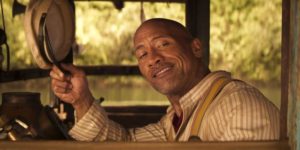
Dwayne Johnson plays Frank Wolff, the charismatic, adventuresome scoundrel that we’ve all seen in action movies a thousand times before. The character, for the most part, is an archetype (which is the same problem almost every character has in this movie). The performance feels redundant to watch because Dwayne Johnson is not a chameleon actor who disappears into a role — this is just Dwayne Johnson doing what he always does. While I love Johnson, his inability to do something different hurts Jungle Cruise. I know Disney wanted a big-name actor who would sell tickets, but Johnson’s charisma cannot save all the problems with this character.
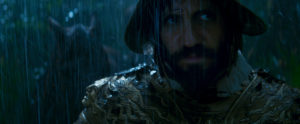
A plot twist reveals that Frank is truly Francisco Lopez de Heredia, a 400-year old Spanish conquistador who came looking for the Tears of the Moon with the villain, Aguirre. When Aguirre attacked the native tribe protecting the magical tree, Francisco turned on him. At first, I was intrigued and happy to be caught off guard by this plot twist; Frank’s character was pretty boring and didn’t have much depth (though this reveal didn’t exactly fix that). However, immediately after this reveal, I couldn’t stop thinking about the plot holes and questionable casting decisions. Frank is a 400-year old Spanish conquistador who’s lived in Brazil all of his life, so why does he have an American accent? Johnson isn’t even of Hispanic descent — he is Black and Pacific Islander. When Frank lets his true accent “slip” as he reveals his real identity, the fake Spanish accent is so bad I almost laughed in the theater. He doesn’t pronounce words in Spanish like a Spanish speaker at all. Meanwhile, the conquistador villains keep their accents and speak entirely in Spanish. Why wouldn’t the same apply to Frank? All of these inconsistencies took me out of the movie for a while, and I couldn’t look at Frank’s character the same. What the movie was telling me directly contradicted Johnson’s performance. I was simply filled with this confused, disappointed feeling.
Lily
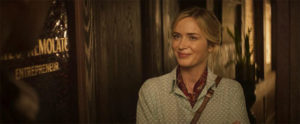
Emily Blunt plays an archetypal character as well. She’s a “strong woman,” which basically means she can do everything Frank can (but swim), and better. I mostly felt indifferent about Lily because I’ve also seen this character many times before. She’s adventurous, a go-getter, impulsive, and brave — all the traits of a stereotypically masculine character, but in a (gasp) woman. Lily’s femininity mainly relies on her being a feminist. I do admire her persistent defiance of the patriarchal society she lives in, but this defiance is often used for comedy in the movie. The worst dragged-out running “joke” in the film is that Lily wears pants. It becomes one of her defining characteristics. It’s 2021, audiences don’t need to watch men make a huge deal out of a woman wearing pants in every single one of her scenes, even if the movie is set in 1916. Beyond her feminism, Lily doesn’t have much of a personality. She wants to help people using the Tears of the Moon, and that’s all. While her quest is a noble one, her character feels like it’s missing emotional depth. She is a protagonist reduced to a feminist symbol.
McGregor
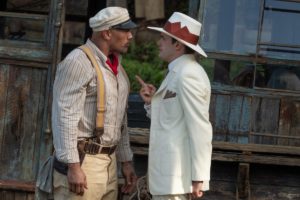
Jack Whitehall‘s McGregor receives the worst treatment out of all the characters. He’s another one of Disney’s poor attempts at gay representation meant to be palatable for all audiences. Amazingly, McGregor’s character dangles crumbs of true representation in front of the gay community while simultaneously seriously offending them. The fact that he’s played by a straight actor doesn’t help. In the first third of Jungle Cruise, McGregor is one of the most disgustingly offensive portrayals of a gay man I’ve seen in modern film. He dresses in pink suits (which wouldn’t be so bad if not for the other ways he’s stereotyped) and constantly complains about staying in such dirty, “primitive” conditions (which are problematic comments on a whole other level). He is used as comic relief and portrayed as a vain, pathetic dandy. He’s humiliated constantly, particularly in a scene when he urinates himself at the sight of a jaguar. He gave me so much second-hand embarrassment while watching.

Yet, once he, Lily, and Frank are well on their way to the Tears, McGregor’s portrayal changes. He remains frivolous and materialistic, but it’s dialed back. The movie suddenly seems to treat him with more kindness, giving him redeemable qualities like loyalty to his loved ones and bravery in near-death situations. Despite the way he acts in the first third, McGregor was my favorite character by the end of the movie. I felt he was a more compelling character than Lily or Frank because of his backstory and emotional intellect. It was the “coming out” scene with Frank that truly changed my opinion. I was worried Frank might immediately say something akin to “Don’t hit on me,” “No homo,” etc. But Frank reacts with no negativity, which was a relief, even if it is the bare minimum. And that’s a term I would use to describe this whole scene: doing the bare minimum. While McGregor does say that his romantic interests aren’t in women but “lie elsewhere,” he never says the word “gay.” He doesn’t even say “I like men.” Disney continues to treat the word “gay” like it’s a bad word, and it’s infuriating.
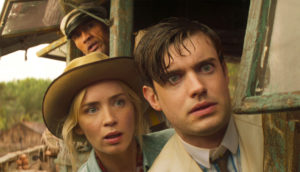
I guess I have to appreciate the crumbs we do get. McGregor is helpful and genuinely funny at times throughout the movie. One of my favorite moments is when he punches Frank and Frank says, “Strong form!” He successfully punches people backwards multiple times. I was honestly surprised they allowed this previously-shown weak character to have physical strength. McGregor is arguably better than the queer characters in both Cruella and Beauty and the Beast because McGregor talks about being gay (even if he doesn’t directly say it) and gets to be a fully fleshed out character who’s along for the whole movie.
The Villains
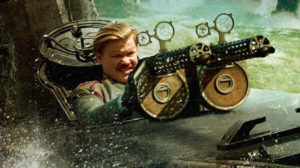
Jesse Plemons plays German aristocrat Prince Joachim, a joke character. He’s a one-dimensional villain that’s played for laughs more than anything else. The man drives a submarine in the Amazon — he’s totally outlandish. If you can tolerate that, then he’s fun to watch. But I spent most of Joachim’s scenes waiting for the much more interesting undead conquistadors to show up.
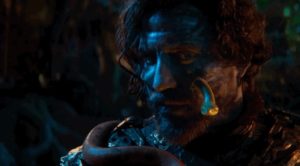
Edgar Ramírez‘s Aguirre and his men were some of the most visually arresting villains (and characters in general) that I’ve seen in a live action movie since Davy Jones in Pirates of the Caribbean. I applaud the VFX artists who did such a wonderful job bringing these villains to life; they steal every scene they’re in. They are also much grimmer than I thought would be in a Disney family movie. Watching Aguirre’s pale flesh move with the slithering of the snakes beneath it was totally disgusting and awesome to watch. Each conquistador was striking. I would have liked to see more of them and their backstory, which I thought was one of the most interesting aspects of the movie. The film touches on their conquistador status and how they are punished for attacking innocent native tribes but doesn’t delve much more into the importance of that history.
The Tribe

I have mixed feelings about the portrayal of the indigenous peoples in Jungle Cruise. The star of the original ride was Trader Sam, a head-hunting, dark-skinned indigenous man. It was a gross, highly offensive stereotype. In the movie, Trader Sam is a woman and her tribe is peaceful. I liked this change for obvious reasons. While the tribe uses the rumors of their violence to isolate themselves from the townspeople, they are truly friendly. This is clearly a purposeful subversion of the cannibalistic, primitive natives trope. In fact, the tribe is in kahoots with Frank to make money scamming tourists. But it’s as if the peaceful tribe and gender-bent Trader Sam’s only purpose in this movie are to subvert a stereotype Disney helped perpetuate in the original “Jungle Cruise” ride. Their inclusion feels like a job on Disney’s checklist of reparations.
Conclusion
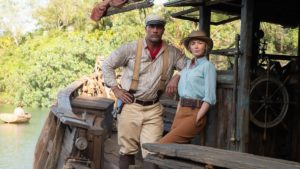
For the most part, Jungle Cruise is some silly family fun, as long as you don’t think about it too much. Going forward, I don’t think Disney should make any more movies based on their theme park rides, especially since most of their rides originated in a time when it was okay to feature racist stereotypes like cannibalistic native peoples. Perhaps they should try writing new stories aimed toward their modern audience. But as long as Disney keeps trying to reinvent the wheel and churn out media based on things they’ve created decades ago, they should keep expecting viewers to find the skeletons in their closet.

Comments